
Chapter 8
MANCE LIPSCOMB--THE GREAT UNKNOWN
He plays with a great steady bass line. Tho he often played with just one bass
note
(instead of alternating), I've changed most of the bass-lines to alternate--to
give you more practice.
Sorry, Mance.
Here are three down-home blues to get you going.
This is a hip but simple blues that continues our study of the ham-mer on.
Remember Rock Me Baby? That piece by Mance had our first ham-mer; it wouldn't
hurt to review it now
(Yes, this book HAS a structure!).
Ah, but this piece's ham-mer is subtly different!
The "Simple" A7 (measure 5) is the same shape here--use your left pinky
for the third fret note.

Soon enough comes the first ham-mer, in:
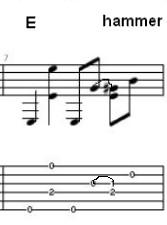
The Ham-mer falls between the Third and Fourth beats
It falls on the Second Half of the Third Beat (Huh?).
Well, play the measure and STOP after the second low E bass note.
Then lift
your left index, and SLAM it down only when your right thumb simultaneously plays
the 4th string (the alternate bass; you know, the same bass note you just played
on beat two).
In Rock Me Baby, the ham-mer fell all alone, without a bass note to have
to deal with at the same time.
But here you START the ham-mer on an
"off-beat"--BETWEEN bass notes. Irritating, isn't it?
This ham-mer is repeated over and over in this tune, so Why Not Try It 'Till It Works.
Ham-mering on and pull-ing off are the two most-often used natural guitar
effects.
When you're older you'll thank me (remember that?).
How to play the slide at the end of Measure 12:
This slide is on the Fourth beat, on the 5th string
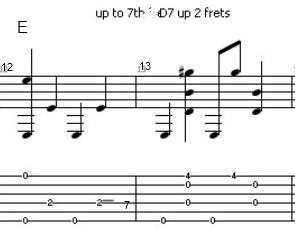
Measure 12: Slide the finger ALREADY on the 5th string (the Left middle), up to the seventh fret--at the same time as sounding it with your Right Thumb.
This will impress everyone (even your kids who might hate old folk and stuff like that).
Measure 13:
Note the weird bassline of 6th and 3rd strings
Move the normal D7 chord up two frets, and Leave It There.
Now play this measure with a bass alternating between the Sixth and THIRD
strings.
This means your right thumb will hit the Sixth and then the THIRD string, for
ONLY this measure. Weird but oddly alluring.
Then return to the normal E for measure 14.
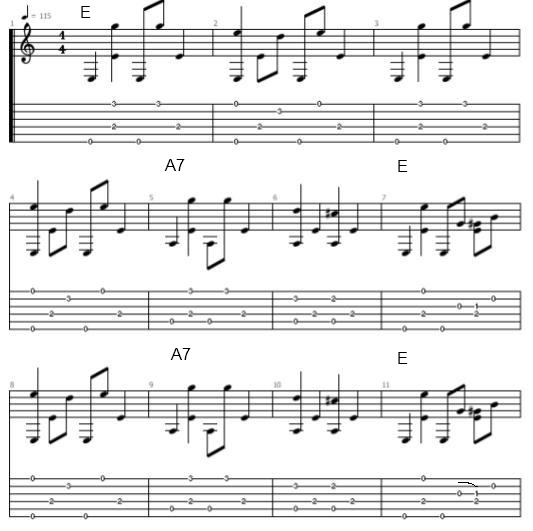
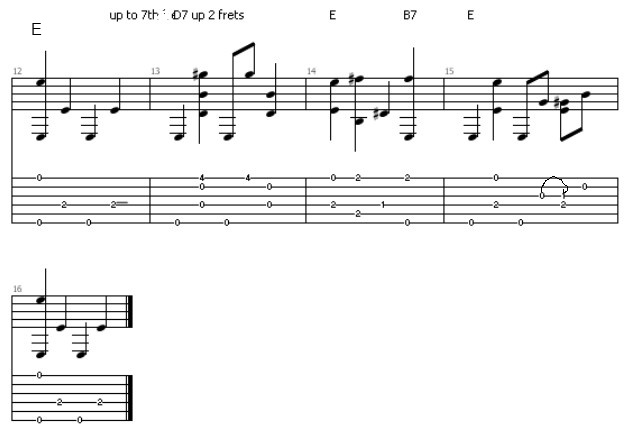
Remember the Creem's classic "Spoonful? This ain't it! But it's from the
same neighborhood.
Maybe blues guitarists in the old South were so broke
they had to use the same name over again for different songs.
This Spoonful starts with a New D chord--really just
two fingers on the fifth and seventh frets.
Use your Left index and middle fingers, even though it's a bit of an abnormal
stretch:
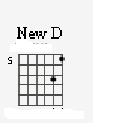
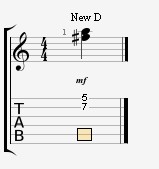
Put your index on the 1st string fifth fret, and middle on the 2nd string seventh
fret.
You'll need finger #3--the ring--for he high B note on the 1st string
seventh fret soon enough.
The pinky gets in the act too (in measure 3).
But start the tune by SLIDING the middle UP to the seventh fret.
This means you don't make the chord when you start this tune, you slide your
middle and then add your index once you land on the correct fret.
This
slide occurs just before the first official measure of the tune--we call
it a "Pickup". It gets you into the first measure.
If a tune has a pickup, Play It. Don't Leave Home Without It.
Measure 1: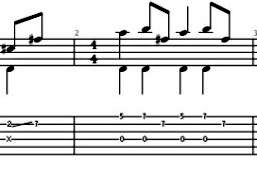
Pickup: Slide middle (from, say, the 2nd string fifth fret) up to the Seventh
fret.
Beat #1: 1) Play the 4th string bass and 1st string fifth fret
simultaneously.
Beat #2: 2) Put the left middle on the 1st string seventh fret. Play
the SAME bass and the new note. Use right middle
.
3) Play 2nd string on off-beat (right index)
Beat #3: 4) Repeat Beat #1
Beat #4: 5) Repeat Beat #2
Next Measure:
Note the Pull-off between the Third and Fourth beat!
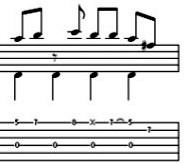
Beat #1: SAME bass again, first with 1st string fifth fret. LEAVE
fingers on and add Ring onto 1st string seventh fret on the off-beat.
Beat #2: Bass alone, then pinky on eighth fret on the off-beat (Still leave
other fingers on!).
Beat #3: Bass alone, but Remove pinky. On off-beat play 1st string
with ring that's still on 7th fret, and PULL IT OFF as you play Beat #4!
Beat #4: Hit Bass note as you pull off Ring. Then play 2nd string alone on off
beat.
This Beat #4 is a bona fide Pull-Off. A Reverse Ham-mer.
When you pull off Left Ring, DON'T PLUCK with your Right hand! Let the Left
finger make the sound as it pulls off the string.
You actually "snap" it off that high "b" note. Make
sure you hit the bass note right
when the snap is heard.
Remember: I hyphenate the words "pull-off" and "ham-mer on"
because each
is TWO separate actions--
playing the original note and then creating a new
note solely with the left hand.
The bass doesn't alternate for this new D chord. I've left this taste of monotony, but I've alternated all the other chords' bass lines.
Keep that bass thumping away underneath! The lyrics to this song are, some say, about frustration.
You may agree after first trying Measure 4, tho in time this one could become one
of your personal favorites, as it is to me. This measure features a new form of
"A chord".
It's formed from a Left index barre
on the four skinniest strings, Second fret. Thus my naming it the
Full A.
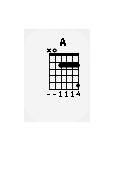
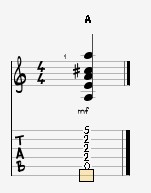
Measure 4:
Slide on the First beat, and pull-off on the Fourth beat
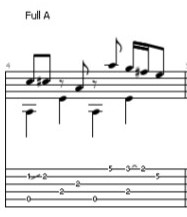
Beat #1: Place the partial barre on the FIRST fret, and SLIDE it up to the next
fret while playing the 2nd string
and the bass (5th string) at the same time.
Beat #2: Play the alternate bass, and then the 3rd string on the off-beat
Beat #3: Original Bass--then Stretch Left Pinky to the 1st string Fifth Fret
and play it.
Beat #4: Play the alternate bass (4th string) and at the same time put Left
Middle on 1st string, 3rd fret.
Pull-Off REAL FAST (faster than you ever thought possible) and slam the poor Left
Pinky on the SECOND string 5th fret.
Keep the four string barre.
Yeah, that last beat was tough. If you can't get it (and who can, at first), just play the bass in Beat #4 alone for now, and work on Beat #4 as a Separate Exercise.
This is what we good guitarists do for the tough measures--
we isolate them, and try them over and over 'till the swelling subsides.
It'll get easier as your left pinky gets stronger. Blues guitarists have great Left Pinkies (isn't that a auto bumper sticker?) and this is how to get one. Ya can't buy 'em in stores.
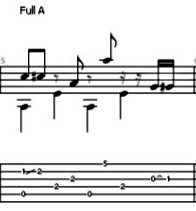
Beats #1, 2, and 3: Same as Measure 3.
Beat #4: Play the bass note, then DROP the barre and ham-mer left index onto
3rd String 1st fret all alone--both ham-mer notes squeezed into the off-beat.
Measures 5 through 7 stay with the normal E chord, using the left pinky a lot.
Measure 8-9 repeat most of Measures 3-4. When playing the piece again--called "playing another Chorus"--stick the "pickup" slide onto the off-beat of the final measure to get you into the new D chord again.
This little piece really swings! Sounds Like This
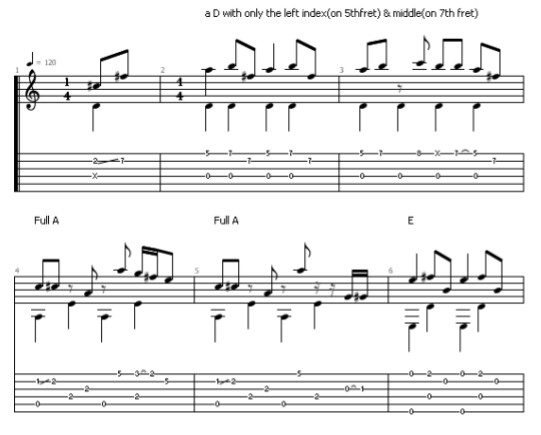
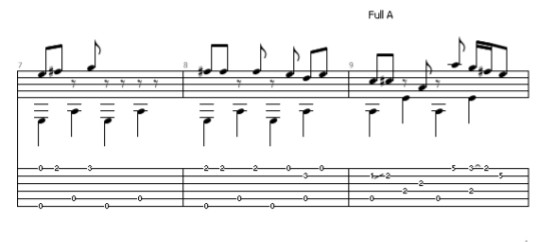
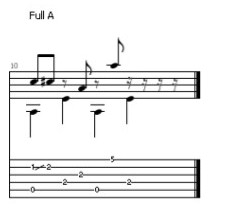
What you gonna do 'bout your brand new pappy? 'Bout a Spoonful,
What you gonna do with your brand new pappy? Lord Mama 'bout a Spoonful!
If Mance had ever needed to scratch his ear with his right hand in the middle of a performance, he could almost do it with this piece.
It's the ultimate ham-mer on study. Sort of "Sor for Sore Eyes" or "Funky Carcassi." By the time you get this piece together, you'll just about be able to ham-mer with your nose!
Measures 1 & 2:

Measure 1:
Beat #1: Pluck Bass and 3rd string (open) together (Right Thumb and Index).
Then with Left Index, slam down ham-mer (1st fret) on off-beat.
Beat #2: Alternate bass (4th string) followed by open 2nd (right middle)
string.
Beat #3: 6th String Bass, followed by 3rd string open on off-beat.
Prepare to Ham-mer! Combat Positions Ready!
Beat #4: Slam index onto 3rd String, First fret while thumb hits alternate bass
at same time. Ham-mer real hard!
Then pluck 2nd string on off-beat. Prepare to Ham-mer again!
Measure 2:
Beat #1: Slam left pinky down on second fret on still-ringing 2nd string (from
Measure 1, beat #4). At Same Time play 6th String Bass.
Then lift Left index and play 3rd string open (right index). Prepare to Ham-mer
one last time!
Beat #2: Slam Left Index on 3rd string simultaneously with bass on 4th string.
Play open 2nd string on off-beat.
Beat #3: Just Bass, then 3rd string 1st fret after.
Beat #4: alternate bass.
That's the worst of it. However, the next two measures are off an
"Altered A7," with the index on the first fret, 2nd string.
This is so you can ham-mer onto the second fret with the Ring.
Altered A7

This is something like a simple A7 except your left RING's on the second fret, and your INDEX is right behind it on the same (2nd) string--so you're ready to ham-mer.
On the fourth string is your middle finger, second fret.
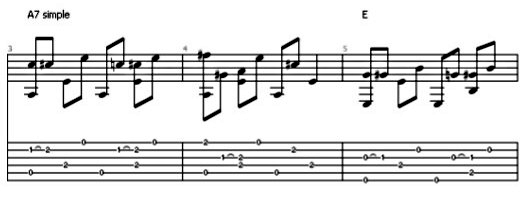
Measures 3 & 4:
(New A7)
Measure 3:
Beat #1: Play 5th string bass together with 2nd string, first fret.
Immediately ham-mer Ring onto 2nd string second fret on off-beat.
Beat #2: Alternate bass (4th string), open 1st string on off-beat
Beat #3: 5th string bass, then 2nd string first fret. Prepare to ham-mer!
Beat #4: Slam Ring onto 2nd fret while hitting alternate bass at same time.
Then play first string open on off-beat, hard--Prepare to Ham-mer!
Measure 4:
Beat #1: Slam left pinky down HARD (ham-mer) on still-sounding 1st string from
previous measure while simultaneously playing 5th string bass. Then pluck 2nd
string on off-beat. Prepare for Last Ham-mer!
Beat #2: Stab 2nd string 2nd fret with Left ring while playing alternate bass
at same time. Then (with dying breath) play open 1st string on off-beat.
Beat#3: Just the bass on-beat, then 1st string off-beat.
Beat #4: the Alternate bass.
See, the trick is to master two different types of ham-mers:
In measure 7, the sliding D7 (see One Thin Dime, Measure 13) reappears:
Luckily measures with the E repeat exactly.
Measure 7:
Pluck three strings simultaneously, finger a D7, and slide this D7 up two frets.
It will sound as an E7 on this (the fourth) fret, but play it only on Beat #1.
Play beat #2 OPEN (look Ma No Left Hand!), and then play a B7 (on beats 3 and 4)
to fill out the measure.
Return to the old-style E for the last measure of the piece. The final ham-mer
(measure 8) should be a breeze by now.
It happens real fast, with both parts
on the On-beat. These are sixteenth notes (if anyone cares by now--you're
probably exhausted!). But look--the off-beat of this beat #2 gets its own open
string note.
Now comes an easier second part! Mance Lipscomb played an INSTRUMENTAL chorus when he recorded this piece. I've included it as the second half of the piece, after the ham-mer happy music we've been working on here.
The ham-mers in the instrumental are so much simpler than in the part
we've just worked on that you should have some success immediately. Just read
the ham-mers slow, and note which ones are on the beat (such as the first one,
Measure 1, beat 1) or off the beat (Measure 2, beats 1 & 2).
Use the same new three fingered A7 for this part.
Consider this instrumental break a reward for learning the first part--don't eat it first and "ignore your vegetables!"
Sugar babe I'm tired of you, you don't love me like you used to do, Sugar babe, It's all over now!


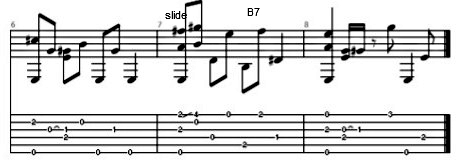
| Back to the Table Of Contents | Trouble reading tablature?: Tablature Help Here |
More info/contact Andy: http://www.andypolon.com